 Latin Rulers of Constantinople
Latin Rulers of Constantinople1204-1261
24-17 mm. 2.10 grams. Trachy.
Bust of Christ
Archangel Michael, winged, XM to right
Byzantine Coins, 1204-1453
(Go to the first page and Table of Contents of this introduction to Byzantine coins. Go to the previous page, "Late Byzantine AE, 1059-1204 (Constantine X to the fall of Constantinople to the crusaders)."
What's new? (March 3, 2020) Theodore I, from the Empire of Thessalonica.
After the crusaders of the Fourth Crusade conquered Constantinople in 1204 they ruled the cities of Constantinople and Thessalonica, but not the rest of the empire. Byzantines from important families set up rival states--the Empire of Nicaea, The Empire of Trebizond (on the south east Black Sea coast), and The Despotate of Epirus, and when Thessalonica was recovered in 1224, The Empire of Thessalonica. Coins of the Empire of Trebizond are found in its neighborhood and easy to distinguish from Byzantine coins, but coins of the Latin rulers of Constantinople, the three other Byzantine states, and the Bulgarians are quite similar and were not clearly distinguished until 1969 when Hendy published Coinage and Money in the Byzantine Empire, 1081-1261. Even so, it is hard for a collector to distinguish them unless he or she has a comprehensive illustrated reference book for the period.
 Latin Rulers of Constantinople
Latin Rulers of Constantinople
1204-1261
24-17 mm. 2.10 grams. Trachy.
Bust of Christ
Archangel Michael, winged, XM to right
Sear 2036. DOC 4.2 Plate L, 16.4.
Coins of the Latin rulers are not yet dated more precisely than their entire control over Constantinople, from 1204 to 1261. Maybe some day hoard evidence will help put them in chronological order. It is certainly the case that a great deal of research has been published in this millennium about these previously understudied coins.
As you can see, there is no identifying legend other than the enigmatic "XM" to the right. How can we know whether this is Latin, Nicaean, or Bulgarian? See Hendy's book and his Dumbarton Oaks volume IV for the evidence. It is not easy to distinguish this coin from other Byzantine-era coins. Sear has a virtually complete list of types, but they are difficult to identify without pictures and Sear has photos of only a fraction of the types. Fortunately, a few well-illustrated references have been published recently.
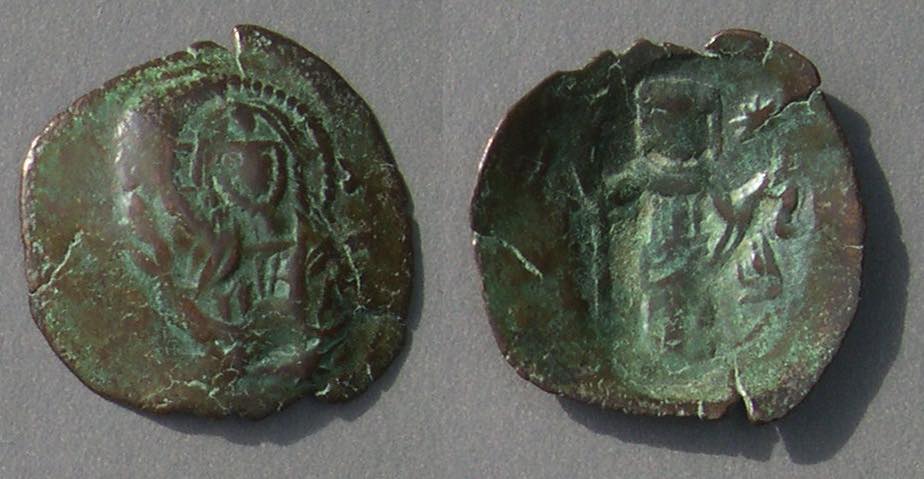 Bulgarian imitative.
Bulgarian imitative.
22 mm. 1.91 grams. Trachy.
Bust of Christ
King standing facing
This is very much like a Byzantine coin, but has been attributed to the Bulgarian King Constantine Asen Tich, 1257-1277.
Dimnik & Dobrinic MSCB 3.1.5, page 220.
Trebizond. When Constantinople fell to the Crusaders in 1204 parts of the empire were retained by locally-important families. Trebizond was founded along the southeast shore of the Black Sea by a Comnenus, Alexius I Comnenus, grandson of Androncius I. The Empire of Trebizond on the south east Black Sea coast was not contiguous with the other Byzantine states. It was surrounded by and paid tribute to the Seljuk Turks and later the Mongols and Ottomans, who ended it in 1461, eight years after the fall of the restored empire. Trebizond had silver mines and most of their coins are good silver.
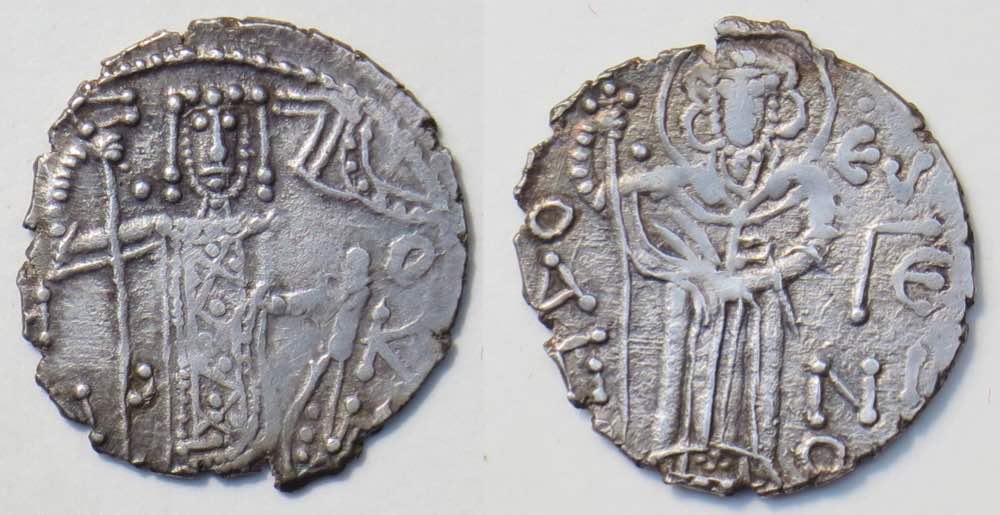 Manuel I of Trebizond. 1238-1263.
Manuel I of Trebizond. 1238-1263.
Silver. 22 mm. An "asper."
Manuel I standing
St. Eugenius standing. ЄVΓЄNIO
Sear 2601.
The great majority of coins of Trebizond are silver. Otto Retowski illustrates about 250 coins on 15 page plates in Die Münzen der Komnenen von Trapezunt.
The Empire of Nicaea. Nicaea was an important Byzantine city (think, the Nicaean Creed) on the Asia side about 100 miles from Constantinople. By 1208 Theodore I Comnenus-Lascaris had established a state there with a second mint at Magnesia, further from the Muslim threat.
 Theodore I, 1208-1221, Empire of Nicaea
Theodore I, 1208-1221, Empire of Nicaea
28-25 mm. 3.01 grams.
Virgin enthroned holding nimbate head of Christ
Theodore and St. Theodore (a military saint in military dress) with patriarchal cross between them
Sear 2061. Struck 1205-1212 at Nicaea.
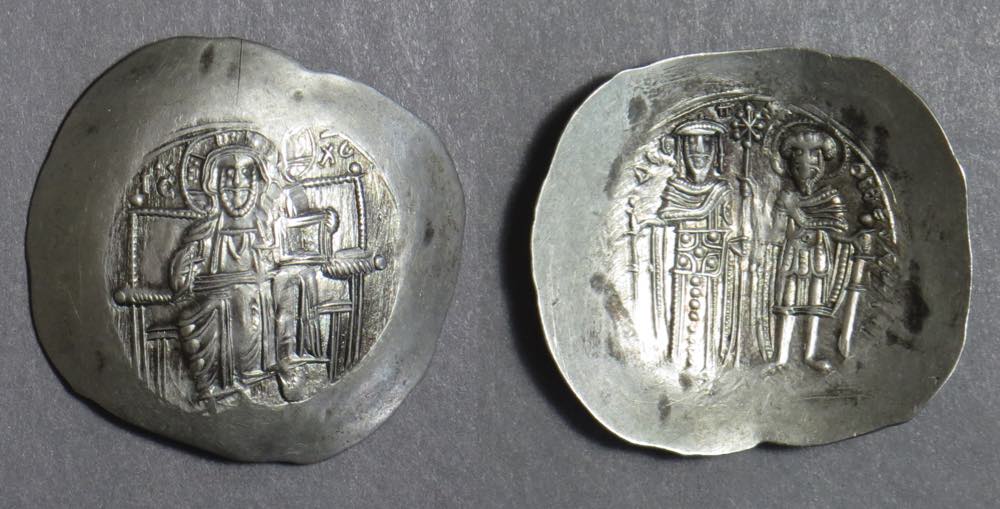 Theodore I, Empire of Nicaea, 1208-1221.
Theodore I, Empire of Nicaea, 1208-1221.
Silver. 33-30 mm. Trachy.
Christ enthroned
Full-length figures of the emperor and St. Theodore
Sear 2064. Mint of Magnesia.
Gold was not issued by Theodore I, but was reinstituted by his successor, John III. This "silver" coin may have a bit of gold in it, but not enough to see by its color.
 Theodore I, Empire of Nicaea, 1208-1221
Theodore I, Empire of Nicaea, 1208-1221
28-26 mm. 3.55 grams. Trachy.
Christ standing
Emperor standing, ΔЄ to left
KOM for Comnenus to the right.
Overstruck on a brockage. You can see the incuse head and cross of a reverse at 7:00-8:00 on the obverse.
Sear -- but would be just before 2067.
The quality of this coin is low, but typical. Trachy are usually double struck and often the key letters intended to identify the emperor on the left and right of the reverse are slurred or not stuck up. This one is badly double struck on the reverse. The second strike of the single figure put him off-center to the left and allowed "KOM" to the right to appear clearly. Usually those letters are obscure. This time they help pin down the identification. Some reference books use line drawings so that all the details from several examples can be shown with one image. It is extremely rare for a single coin to show all the details present on the dies.
John III, Ducas, called Vatatzes, 1221-1254.
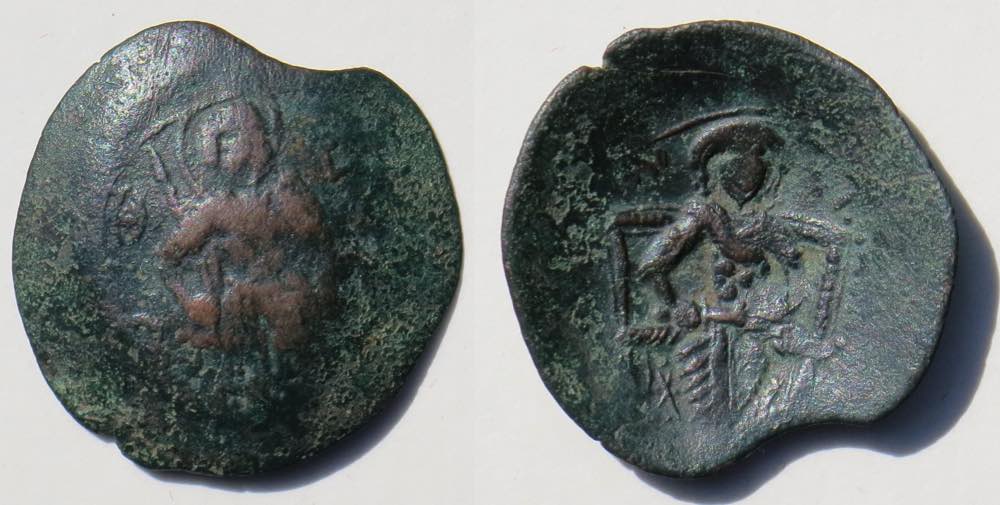
John III, 1221-1254. Empire of Nicaea.
29 mm. 3.26 grams. Trachy.
Full length figure of St. George, right hand holds spear resting over his shoulder
Emperor enthroned
Sear 2108. DOC IV part II John III 54.
Magnesia mint.
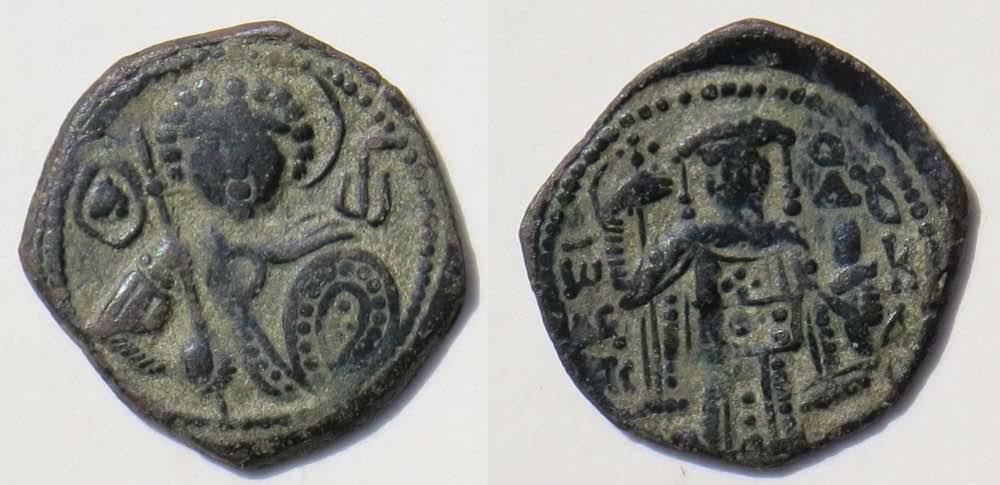 John III, 1221-1257, Empire of Nicaea
John III, 1221-1257, Empire of Nicaea
19 mm. 2.07 grams. Tetarteron.
Full length figure of St. George, right hand holds spear resting over his shoulder.
Emperor standing, legend to left and right
IωΔЄCΠC OΔɣKAC
Sear 2116. Magnesia mint.
 Theodore II, 1254-1258, Empire of Nicaea,
Theodore II, 1254-1258, Empire of Nicaea,
27-22 mm. 2.59 grams. Trachy.
St. Tryphon standing, lis to right
Emperor standing.
Sear 2142. Grierson 1188.
Again, the general design and (non-existent) legends are not very distinctive, but the lis is. With a reference books with many coins of this era illustrated, this coin can be identified.
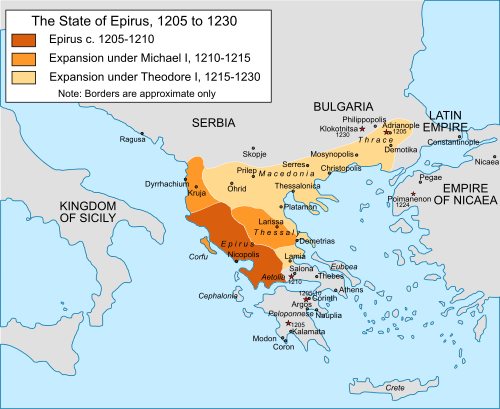 Empire of Thessaloncia (The tan-colored area on the map from wikipedia). Theodore Angelus Comnenus Ducas, 1225-1230. In 1215 the Crusaders ("Latins") were in charge of Constantinople, a region around it, and some of Greece (the tan-colored area on the map from wikipedia) including Thessalonica, the second-largest city after Constantinople. The Despotate of Epirus occupied the west coast of Greece. The Bulgarians occupied much of the rest of the Balkins. The Empire of Nicaea occupied Asia Minor outside the Latin territory. Theodore became ruler of the Despotate of Epirus in 1215 upon the death of his half-brother Michael Angelus. (There is a different Theodore, Theodore I Lascaris, who was Emperor of Nicaea.) He was a relative of three of the most promient Byzantine families, which explains all those names. In 1224 Theodore reconquered Thessalonica from the Latins and founded "The Empire of Thessalonica". In 1230 he invaded Bulgarian territory and lost his army and was captured by Ivan (a.k.a. John) II Asen, the Bulgarian Tsar. Initially treated well, he was blinded after plotting against Ivan. Amazingly, that was not the end of his political involvement. After many more complicated events, Ivan's first wife died during an epidemic and Theodore managed to persuade Ivan to take his, Theodore's, daughter, Irene (who then was renamed Anna) as his new wife. As father-in-law of the Tsar, he was released, went back to Thessalonica in disguise, and deposed his brother, Manuel Comnenus-Ducas, in 1237 and installed his son, John Comnenus-Ducas, who was "emperor" only until 1242 and then was obliged to accept the lessor title of "despot" and acknowledge John III Comnenus-Dukas, emperor of Nicaea, as overlord. John III of Nicaea took full control in 1246, bringing the "Empire of Thessalonica" to an end. (This is only one of many sequences of events where the history is truly "Byzantine.")
Empire of Thessaloncia (The tan-colored area on the map from wikipedia). Theodore Angelus Comnenus Ducas, 1225-1230. In 1215 the Crusaders ("Latins") were in charge of Constantinople, a region around it, and some of Greece (the tan-colored area on the map from wikipedia) including Thessalonica, the second-largest city after Constantinople. The Despotate of Epirus occupied the west coast of Greece. The Bulgarians occupied much of the rest of the Balkins. The Empire of Nicaea occupied Asia Minor outside the Latin territory. Theodore became ruler of the Despotate of Epirus in 1215 upon the death of his half-brother Michael Angelus. (There is a different Theodore, Theodore I Lascaris, who was Emperor of Nicaea.) He was a relative of three of the most promient Byzantine families, which explains all those names. In 1224 Theodore reconquered Thessalonica from the Latins and founded "The Empire of Thessalonica". In 1230 he invaded Bulgarian territory and lost his army and was captured by Ivan (a.k.a. John) II Asen, the Bulgarian Tsar. Initially treated well, he was blinded after plotting against Ivan. Amazingly, that was not the end of his political involvement. After many more complicated events, Ivan's first wife died during an epidemic and Theodore managed to persuade Ivan to take his, Theodore's, daughter, Irene (who then was renamed Anna) as his new wife. As father-in-law of the Tsar, he was released, went back to Thessalonica in disguise, and deposed his brother, Manuel Comnenus-Ducas, in 1237 and installed his son, John Comnenus-Ducas, who was "emperor" only until 1242 and then was obliged to accept the lessor title of "despot" and acknowledge John III Comnenus-Dukas, emperor of Nicaea, as overlord. John III of Nicaea took full control in 1246, bringing the "Empire of Thessalonica" to an end. (This is only one of many sequences of events where the history is truly "Byzantine.")
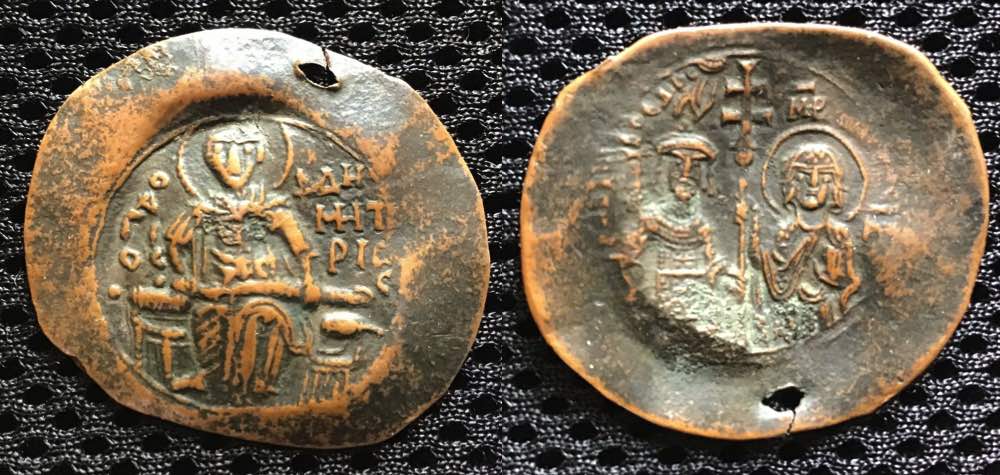
Theodore of Thessalonica, Comnenus-Ducas
31 mm. Originally cup-shaped, but partially squashed since then.
Struck c. 1227/8
St. Demetrius (patron saint of Thessalonica)
O AΓIOC ΔHMHTPIOC
Emperor left and Virgin with halo right holding patriarchal cross (two crossbars)
ΘЄOΔωPOC ΔЄC MP [above Mary] ΘV [to the right]
(Theodore Despot. Mother of God)
Sear 2167
DO IV.II Theodore 9
Michael VIII, Palaeologus, the restored empire, 1261-1282. Michael VIII founded the Palaeologid dynasty which lasted until the end of the empire in 1453. In 1258 he became regent for the the last Nicaean emperor and in 1261 he reconquered Constantinople and "restored" the Byzantine empire.
Most Palaeologid types were rare and barely studied until the 1980's. The first edition of Sear did not even attempt to list them all, but, with the help of Simon Bendall, the great expert on late Byzantine types (who, unfortunately, died in 2019), the second edition is nearly complete. You would need some other reference work for photographic coverage, but such books exist now and they didn't in 1980.
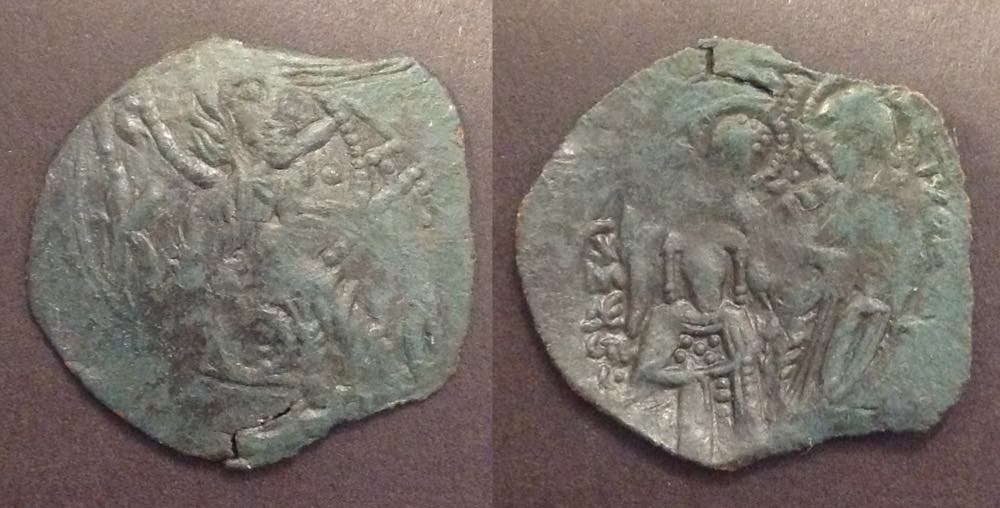
Michael VIII, Palaeologus. 1259-1282.
25-22 mm. 1.49 grams.
Bust of Christ, K to left
Three figures. Michael kneeling below seated Christ on right, supported by St. Michael.
XMΔЄCΠ
Sear 2259. DOC V.II plate 4, 46-51.
Palaeologid coins usually have serious flan cracks, irregular flans, and poor strikes. Many types were unknown in the west until after the Iron Curtain came down. It is easy to see why scholars avoided this area of study until the corpus filled out and hoards were recorded. Who wouldn't rather work with attractive Greek and Roman coins?
Andronicus II, 1282-1328.
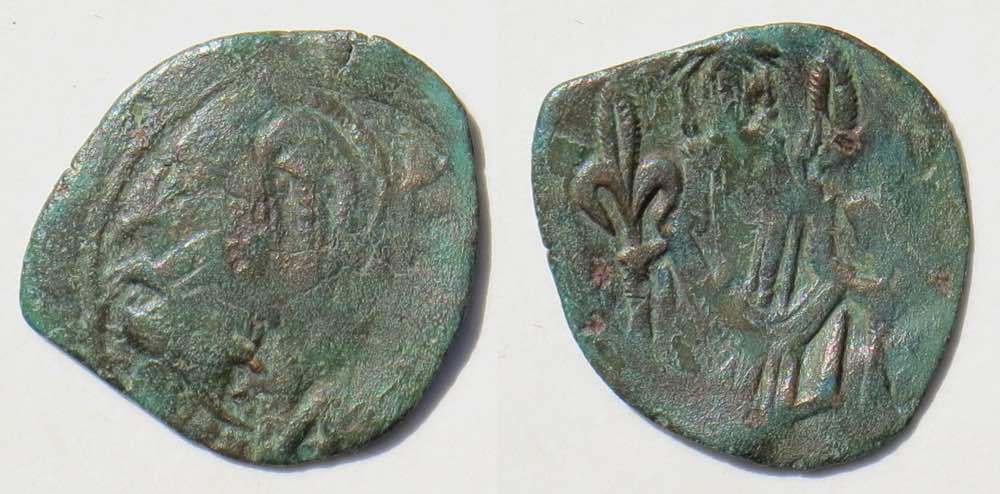 Androncius II, 1282-1328, as sole ruler 1282-1295.
Androncius II, 1282-1328, as sole ruler 1282-1295.
23-22 mm. 1.82 grams.
facing bust of Christ
Full-length figure of emperor with large fleur-de-lis in each hand.
Sear 2372
Some coins are cup-shaped, but during the Palaeologid dynasty the diameters are reduced and the cup-shape less pronounced. Also, many flat coins are issued.
 Andronicus II, 1282-1328, struck 1303 or 1318, as indiction year 1 of a fifteen-year cycle.
Andronicus II, 1282-1328, struck 1303 or 1318, as indiction year 1 of a fifteen-year cycle.
19 mm. 1.54 grams. Flat.
Andronicus II and Michael IX
NA for year 1, with a curved line above the N
Sear 2432. Grierson 1481.
An indiction was a fifteen-year period of time which was used for fiscal planning. When a reign lasts more than 15 years some indiction years appear twice--fifteen years apart, which is why the date of this coin is given as "1303 or 1318". There are rare coins of Justin dated by the indiction year, but the practice lapsed until resumed very under Andronicus II.
Comment for Collectors: Palaeologid coins generally have extremely low quality. Ragged flans, poor strikes, crude designs, and lack of identifying lettering are all more common than not. Before the 1990s (when the Iron Curtain came down) they were rare in the West and high priced because of their rarity, although there were very few coins offered and very few collectors interested in them. Now we know they exist in large numbers, but their terrible quality still entices few collectors. Prices are now below Sear's values. Some dealers still price them high as if Sear's values were relevant (hoping you have not read this), but they are not. If a Palaeologid coin has good quality (almost unheard of) it can command much more, but coins of typical quality like most of these should be under $50. There are very many types (unlike for emperors in the 8th-10th centuries) and individually many are rare or very rare, but demand is equally rare. I doubt many collectors are attempting to assemble complete sets, so even rarities can go low. On the other hand, any piece of high quality is immediately noticeable and will not go low.
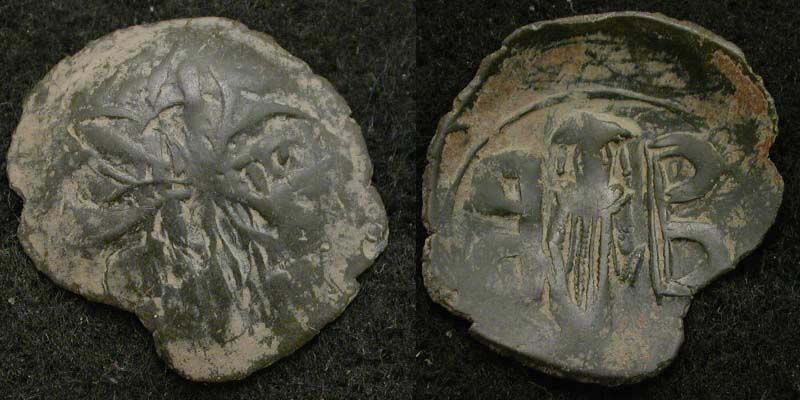
Andronicus II, 1282-1328.
22-20 mm. 1.66 grams.
large six-pointed star
Emperor standing facing between large B on right and large backward B on the left.
This arrangement of B's is associated with the Palaeologid dynasty.
Sear 2393
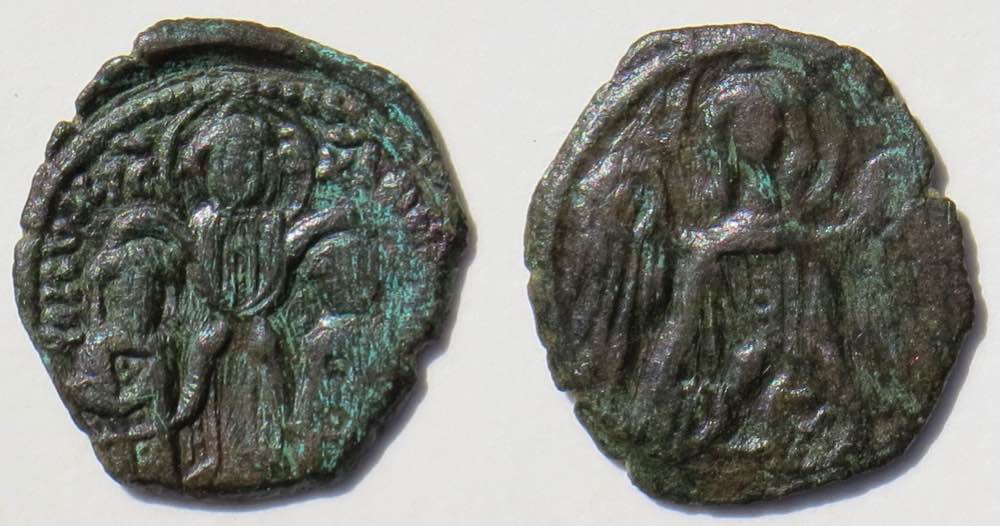 Androncius II, 1282-1328, and Michael VIII, 1295-1320
Androncius II, 1282-1328, and Michael VIII, 1295-1320
21-19 mm. 2.52 grams.
Christ ith his hands on the heads of by 3/4-length figures of Androncius and Michael and either side.
Archangel, holding sword or scepter over his right shoulder
Sear 2435. LPC page 88 #36.
This coin, even though it is not great, has higher quality than most and is probably worth twice what most others are.
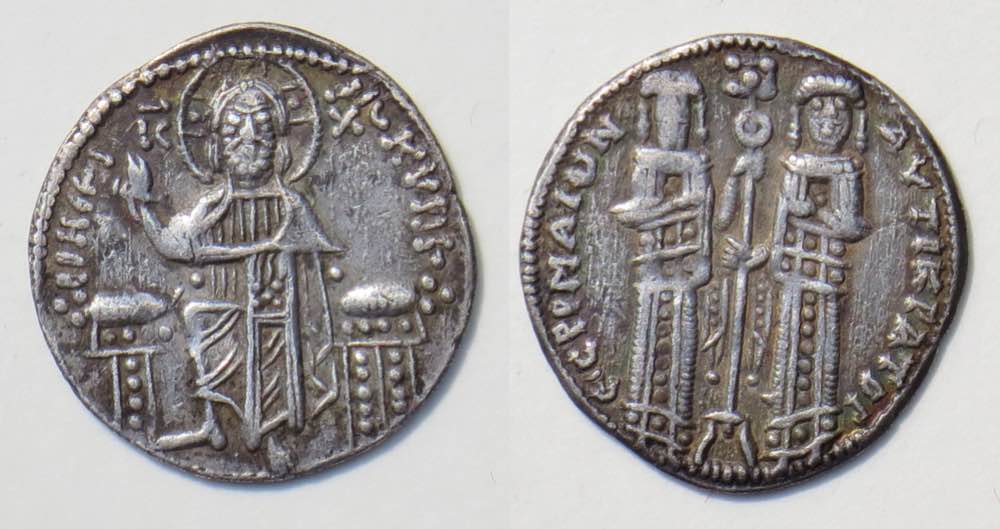
Gold was issued too, but is usually found clipped (gold has been trimmed from the edges).
 Andronicus II and Andronicus III, 1325-1328
Andronicus II and Andronicus III, 1325-1328
clipped AV 22. 3.48 grams.
Facing Virgin Mary orans (holding up her hands in blessing) within city walls with four group of three-turrets each. A sigla (like a fleur-de-lis) to the left and an A (crossed low) to the right.
Christ in the middle blessing the emperors.
Sear 2461. DOC V.II plate 30, 494. DO has several similar coins clipped this much or more.
Here is an off-site map of Europe in AD 1300. (The Byzantine Empire is in pink. There is little territory left except some of the Balkans and some of the west part of Asia Minor [Asian Turkey])
Andronicus III, 1328-1341, Grandson of Androncius II.
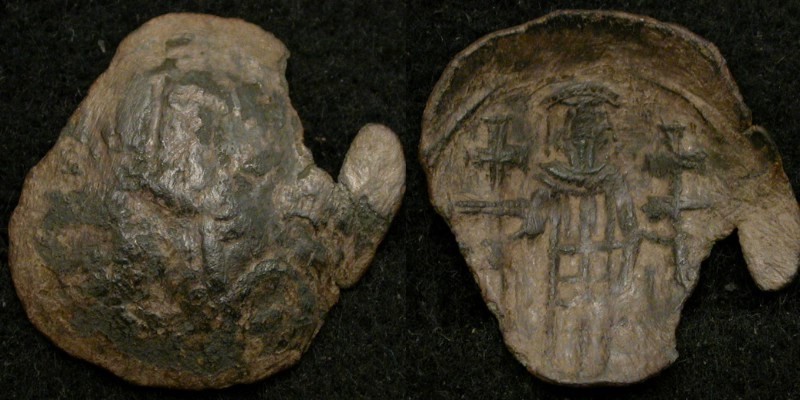
Andronicus III, 1328-1341
22-20 mm. Very ragged flan.
St. Demetrius, half-length (very weak).
Emperor standing with two patriarchal crosses.
Patriarchal crosses are common on Palaeologid coins.
Sear 2486. LPC Andronicus III page 236-7 #6
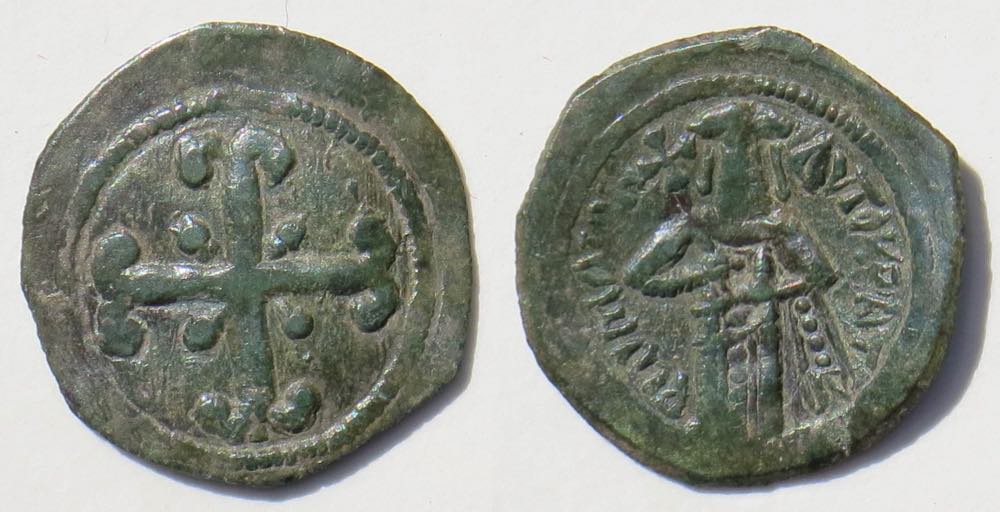
Andronicus III, 1328-1341
21-20 mm. 1.61 grams. The type is flat, but this piece has a slight bend.
Cross fleury
Standing figure of Androncus III holding cross-scepter
PωMAIO AVTOKPAT (of the Romans, emperor)
Sear 2481.
After Andronicus III. From the next emperor, John V, 1341-1391, to the end of the empire in 1453, all copper coins are very rare. It seems the Byzantine state was too busy with external threats to bother with providing small change for the everyday needs of the citizens. However, gold and silver were still being produced and are quite available today. Their quality is low which deters many collectors, so examples are not expensive.
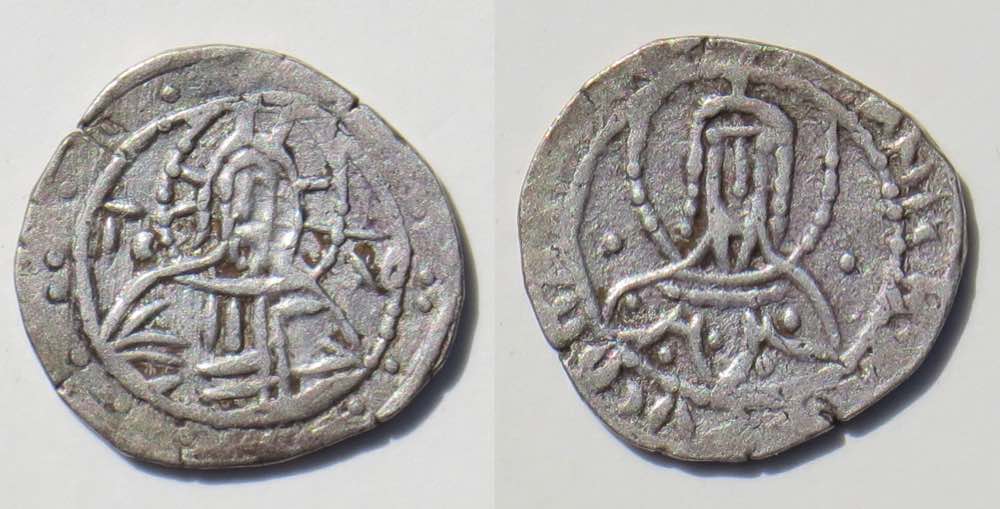 John VII, 1399-1402
John VII, 1399-1402
20 mm. 3.76 grams.
Silver half-stavraton (the names of the denominations are not certain and reported variously)
Bust of Christ facing, holding book of gospels
Bust of John facing.
The name John is written from 1:00 to 2:00 and only "AN" is legible.
Sear 2562.
Here is an off-site map of Europe in AD 1400. (The Byzantine Empire is in pink. You can see there is almost no territory left except the city of Constantinople itself.)
John VIII, 1423-1448, the Second-Last Byzantine emperor.
 John VIII, 1423-1448.
John VIII, 1423-1448.
Constantine XI, 1448-1453, the Last Byzantine Emperor.
The tragic story of the last Byzantine emperor, unable to get aid from the west and besieged by the Ottoman Turks, bravely leading the defense of Constantinople and dying in battle--his body never to be found--has been often told. Now only about 100 of his coins, all silver and almost all from a single hoard, have been found. Even the small ones command thousands of dollars [None are shown here]. On the other hand, if you want a small silver of Mehmet II, conqueror of Constantinople in 1453, that is easy.
 Mehmet II, 1451-1481
Mehmet II, 1451-1481
Silver 10 mm "akcheh"
Mehmet II reigned a long time and issued large numbers of these small coins. There are so many that their price is as low as any ancient or medieval coin.
The end (except for reference works).
The first page outlines the coinage and discuss dates and mints.
The second page is "Byzantine-Coin Letters, Numerals, Denominations, and Dates."
The third page illustrates coins from 491- c. 1118.
The fourth page is "Late Byzantine AE, 1059-1204 (Constantine X to the fall of Constantinople to the crusaders)."
This page was 1204 to the end.
There is a page on reference works.